Operational Analysis Report on Shanghai Housing Provident Fund in 2012
In 2012, good result was harvested in SPFMC’s innovation drive toward transformational development under guidance of macro regulatory policies with a focus on coverage expansion of housing provident fund system and improvement of service management. Orderly stable operation was maintained for housing provident fund, with steady growth in performance indexes of various services such as collection amount, number of paying employees and withdrawal amount. New progress was made in orchestrating investment and loans to support security housing construction.
1. Performance Indexes of Various Services
——HPF Collection: Collection of housing provident fund and additional provident fund totaled 55.644 billion yuan for 2012, up 19.06% year-on-year, including 42.794 billion yuan for housing provident fund accounting for 77%, and 12.85 billion yuan for additional provident fund accounting for 23%. The collection accumulation of housing provident fund and additional provident fund amounted to 354.8 billion yuan as of end of 2012.
——HPF payment: HPF paying units of the municipality as of end of 2012 totaled 0.1358 million, up 18600 units, 15.87% year-on-year. Paying employees totaled 4.8758 million, up 0.374 million employees, 8.31% year-on-year.
——HPF withdrawal: HPF withdrawal in 2012 totaled 28.23 billion yuan, increased 17.42% year-on-year, including withdrawal of 21.298 billion yuan due to housing consumption with a year-on-year increase of 14.49%, and withdrawal of 6.932 billion yuan due to account closure cases such as retirement with a year-on-year increase of 27.47%. HPF withdrawal accumulation as of end of 2012 totaled 194 billion yuan, equivalent to 55% of collection accumulation.
——HPF home loans issued: HPF home loans issued in 2012 totaled 41.038 billion yuan, up 54.83% year-on-year, for a total of 0.1118 million households, up 52.52%, including home purchase loans of 4.11 billion yuan issued for joint-ownership security housing (affordable housing) for 16300 households. The balance of HPF home loans as of end of 2012 was 142.05 billion yuan, up 21.739 billion yuan from the beginning of the year. The accumulation of HPF home loans totaled 300.867 billion yuan , which was issued to 1.6753 million households for purchased building area of 0.152 billion square meters.
——Risks of HPF loans: Deliquency rate for HPF home loans by end of 2012 was 0.090‰, down 3.26% year-on-year.
——HPF value-added proceeds: Revenues for HPF services in 2012 totaled 7.722 billion yuan, and expenditure on services totaled 4.195 billion yuan. Value-added proceeds realized were 3.527 billion yuan, up 154.66%.
2. Characteristics of Operation of Shanghai Housing Provident Fund in 2012
(1) Collection again reached record high in terms of numbers of paying units and employees and collection amount, with significant increase in payment generated from mid-and small-sized paying units.
HPF system coverage expansion was of great significance. In 2012, SPFMC adopted a host of measures to ratchet up impetus for expansion of paying employees and collection amount through various means and channels. Firstly, publicity was strengthened to increase awareness and understanding of housing provident fund, and elevate social influence of housing provident fund by means of tailored advertisement aiming at newly-established units and nonconforming units, and public service ads for publicity through mass media. Secondly, special law enforcement actions were taken in tandem with implementation of “Methods on Administrative Law Enforcement and Administration”, to promote legal awareness of housing provident fund system amongst units and employees. Thirdly, measures were taken to establish additional payment channels and outlets, and to extend service hours to facilitate HPF payment and withdrawal for paying untis and employees. This slew of activities resulted in faster increase in numbers of accounts newly opened for liable units, paying employees and collection amount. Statistics showed the number of accounts newly opened for liable units reached 29000, up 30% year-on-year, additional paying employees 655000, HPF collection 55.644 billion yuan, up 19.06%. The numbers of paying units and employees, and collection amount reached record high again. Below is a diagram illustrating evolution of HPF paying units, paying employees and collection amount over the last five years:
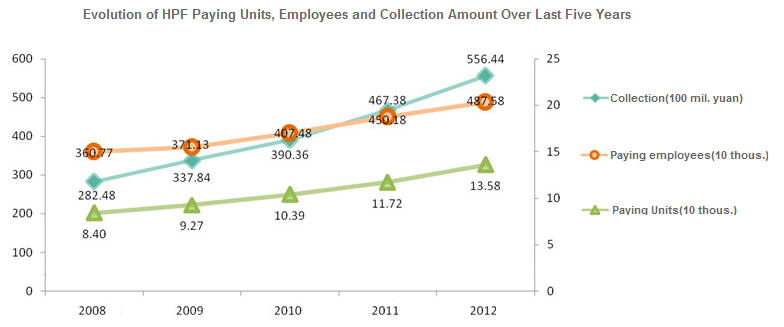
Private businesses topped the growth rates of paying employees at 27.3% according to further analysis of paying units in 2012, followed by foreign-funded enterprises, collective enterprises and state-owned enterprises, up 6.5%,6.4% and 2.8% respectively. Below is a diagram of growth rates of paying employees for various types of enterprises in 2012:
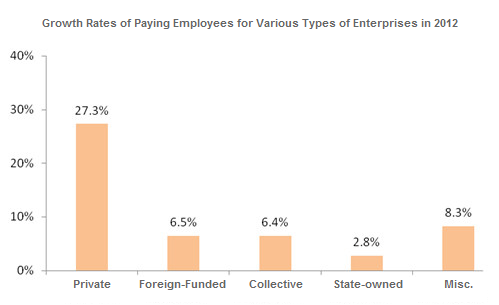
Amongst the additional paying units in 2012, the percentage rate of mid-and small-sized enterprises was on the rise, up 2 percentage points year-on-year, 70.6% for businesses with 1 to 5 employee(s), 84.5% for businesses with 1 to 10 employee(s). Businesses with over 50 employees only covered a percentage rate of 2.3% of the whole additional paying units. Below is a diagram of percentages for enterprises of various scales amongst additional paying units of HPF in 2012:
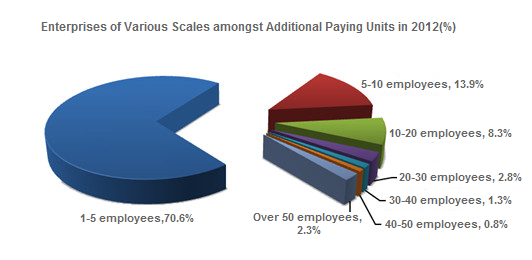
The above-mentioned growth of paying employees and structural changes indicated common development of enterprises of various ownerships and growing momentum of mid-and small-sized enterprises in the municipality, shored up by the strategy of innovation and transformational development.
(2) Diversified Channels of HPF Withdrawal and Structural Changes of Withdrawal
HPF withdrawal of the municipality in 2012 featured a faster increase at a rate of 17.42%, up 11 percentage points year-on-year, a peak level in comparison with percentages of increase over the last five years. Below is a diagram of growth rates for withdrawal amounts from 2008 to 2012:
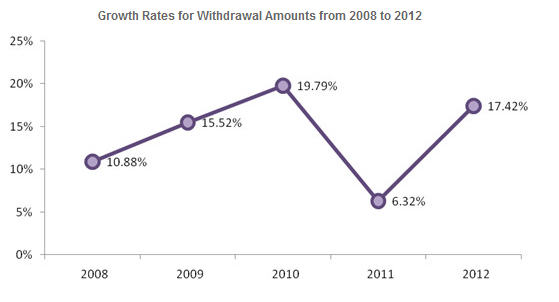
Fast growth of withdrawal amount mainly attributed to significant increase in withdrawal due to both housing consumption and account-closing cases, with percentages of increase reaching 14.49% and 27.47% respectively. Regarding withdrawal due to housing consumption, new policies on withdrawal boosted growth of withdrawal, apart from withdrawal increase due to home purchase loans repayment via housing provident fund accounts. The municipality enacted and implemented a series of HPF use policies in 2012 such as withdrawal of HPF to pay property service charge, and withdrawal of HPF due to loans repayment via housing provident fund accounts for borrowers of not-yet-commissioned commercial banks, in tandem with the previous policies on withdrawal due to rent payment, withdrawal for home purchase of joint-ownership security housing (affordable housing) preceding borrowing. Withdrawal of HPF in 2012 in line with new policies totaled approximately 16500 person-times, amounting to 500 million yuan worth of withdrawal, an unprecedented scale for similar withdrawal cases in history.
Withdrawal due to account-closing cases mainly comprised two types of withdrawal, including withdrawal due to retirement or honoured retirement and withdrawal due to labour relationship transfer of employees out of the municipality, which had been covering 94% of account-closing type of withdrawal all the time. with the latter growing at a faster pace in recent years at 43.4% year-on-year for 2012, 18 percentage points higher than the growth rate of the former, reaching a proportion as high as 9% of the entire withdrawal, in the wake of 3% in previous years. In contrast, withdrawal due to retirement or honoured retirement shrank from the last year, indicating changes in labor force elements market.
(3) Unelastic demand propeled growth of HPF home loans, and lending support strengthened for purchase of joint-ownership housing.
Sales prices of commercial residential buildings were relatively stable in the municipality in 2012 under the influence of prevailing macro-regulatory policies. The central bank cut interest rates of both commercial bank loans and housing provident fund loans for home purchase twice within the year, and thus reduced costs of home loans. Relative stability in prices and easy monetary policies triggered release of housing demand. Sales areas of commercial residential housing in Shanghai began to climb month-on-month in August according to sources from municipal statistics bureau, with annual sales areas of commercial residential housing from January through December reaching 15.9263 million square meters, up 8.1% year-on-year. Under the circumstances of growing sales quantity of commercial residential housing in the municipality, 36.928 billion yuan worth of provident fund loans were issued in 2012 for purchase of ordinary commercial residential housing (other than joint-ownership security housing), up 41% year-on-year, with August being the peak, equivalent to 4.64 billion yuan, slight fluctuation at peak levels in the second half year confined to a narrow range, and monthly average of the year at 3.077 billion yuan.
Below is a diagram of data for sales areas of commercial residential housing, and provident fund loans issued in 2012 for purchase of ordinary commercial residential housing:
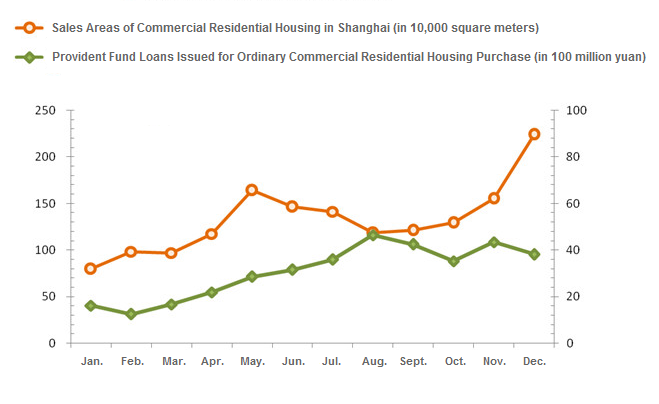
Growth of provident fund home loans issued in 2012 also attributes to significant increase in provident fund loans for purchase of joint-ownership security housing (affordable housing), which were issued in three batches and amounted to 4.11 billion yuan, a 12.9-fold rise from the annual of 0.318 billion yuan in 2011, for 16300 households equivalent to 55% of the contracted purchasers in the municipality, and average sum of loans per household for the three batches of purchasers being 0.249 million yuan, 0.255 million yuan and 0.274 million yuan respectively. Incremental increase in average sum of loans per household indicated further enhancement of support of housing provident fund loans for purchase of joint-ownership security housing.
(4) “Investment and lending were orchestrated” and new progress was made to shore up security housing construction.
SPFMC initiated to invest HPF value-added proceeds in public rental housing and lend provident fund balance to supporting construction of security housing in 2012 after approval by municipal HPF management commission, setting a stage for “orchestrating investment and lending”, thus making new progress in supporting security housing construction.
Regarding investment in public rental housing, official leasing to the public was initiated upon completion of interior decoration at beginning of 2012, in the wake of purchasing in whole 2200 sets of apartments as public rental housing at “Shang Jing Yuan” in New Jiang Wan City. 1581 households of conforming HPF paying employees had completed contract-signing procedures as of end of 2012, with an occupancy rate of 71.9%. SPFMC made another purchase of public rental housing in 2012 by using value-added proceeds at “Jing Hua Fang” of Shanghai Jing Cheng, comprising a building area of 0.1167 million square meters (1680 sets of apartments, of various types). Jing Hua Fang public rental housing is currently in decoration phase. The successful purchase of public rental housing at both Shang Jing Yuan and Jing Hua Fang marked a milestone in pursuit of new ways of using HPF value-added proceeds in Shanghai.
In terms of lending provident fund to supporting security housing construction, as one of the initial batch of pilot cities for trial on use of HPF balance in support of security housing construction publicized in 2011, Shanghai got approval in 2012 from the three ministries including Ministry of Housing & Urban-Rural Development, of HPF loans in support of construction of the second batch of security housing, to further expand scales of pilot projects on trial. The second batch of pilot projects comprised two projects on joint-ownership security housing (affordable housing), three public rental housing projects and eight projects on renovation of shanty areas, with HPF loans totaled 11.362 billion yuan. As of end of 2012, an accumulation of 3.03 billion yuan of loans had been issued pursuant to project schedules, which shored up construction of security housing.
(5) Interest rates cut buoyed growth of HPF value-added proceeds.
Balance of HPF services payment surplus in 2012 grew in 2012 with faster increase in value-added proceeds due to effects of multi-factors, with main reasons as follows. First, central bank’s interest rates cuts in June and July 2012 resulted in slides in interest rates for HPF loans, which consequently generated more HPF interest revenues and relatively less interest payment owing to time difference between actual effective dates for new interest rates for deposits and loans and interest rates differential effect. Second, interest rate for HPF loans in support of security housing construction can be adjusted to a floating rate 10% above interest rate for HPF home loans over five years according to relevant regulations. HPF loans issued in 2012 for pilot projects was 2.38 billion yuan, which increased interest revenues. Third, the upper limit for floating range of deposit interest rates for financial institutions was adjusted to a 1.1-fold rise over benchmark interest rate in accordance with publication of central bank in June 2012. SPFMC coordinated with relevant financial institutions in a timely manner to adjust deposit interest rates pursuant to upper limit of floating rates accordingly, which resulted in the increase in deposit interest revenues.
3. Major Issues of Concern for 2013
In 2013,which is the starting year for implementation of resolutions of “18th CPC Congress”, great effort is to be made for realization of transformational development of Shanghai housing provident fund management with further emancipation of mentality for innovation under guidance of resolutions of “18th CPC Cogress”.
(1) Striving to create new situation for HPF coverage expansion aiming at faster growth of paying employees and collection amounts.
In 2013, great effort is to be made to tackle the problems with HPF payment for highly mobile corporate employees and migrant workers, striving to create new situation for HPF coverage expansion campaign with further emancipation of mentality under guidance of speeding up urbanization development for integration of urban and rural areas stated in the report on “18th CPC Congress”. Meanwhile, social publicity and administrative enforcement are to be strengthened, with a host of measures taken to provide more convenient services to employees and promote more rapid growth of paying employees and collection amounts.
(2) Proactively improve HPF policies on withdrawal and shore up housing consumption of employees.
SPFMC shall further improve policies of the municipality on HPF withdrawal with an aim to streamline HPF use and promote reasonable housing consumption within the framework of laws and regulations, gradually relax constraints on withdrawal policies on condition of an assured direction of HPF use for compliance with laws and regulations, for convenience and interests of employees, and for promotion of consumption.
(3) Implement national regulatory policies on real estate and proactively bolster demand for improvement-oriented self-occupancy housing.
SPFMC shall continue implementing national regulatory polices on real estate, strictly administer differentiated HPF home loans policies, and proactively bolster the demand of HPF paying employees for improvement-oriented self-occupancy housing consumption; continue leveraging the fund as an advantage and allocating pertinent balance of the fund as loans to support security housing construction, and strictly abide by relevant national regulations, enhance post-lending management to avert potential risks, and moreover, continue increasing investment of HPF value-added proceeds in public rental housing so as to provide mid-and low-income HPF paying employees with more public rental housing of higher standards of habitability.
(4) Continue taking measures to improve various services and servicing standards.
Measures are to be taken, with further transformation of servicing philosophy, to continue providing more convenient services, quickening the pace toward “one-door” HPF services aiming at ultimate convenience to paying employees, and meantime fulfill commitment to improvement of servicing attitude and quality. Public supervision mechanism shall be appropriately introduced in 2013 for more effective social supervision and promotion of HPF servicing standard improvement.
Shanghai Provident Fund Management Center
2013.2

